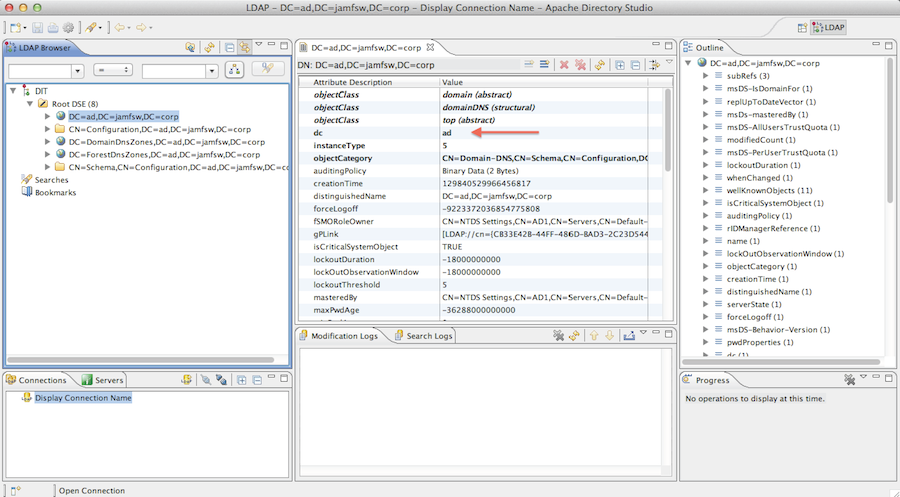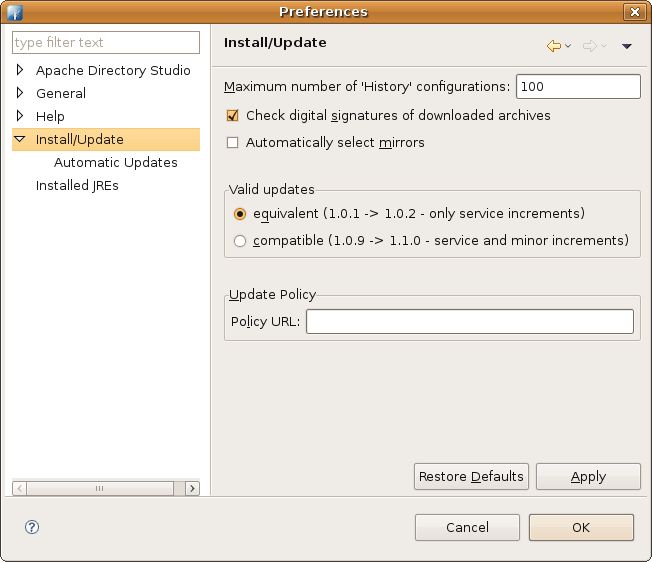

- APACHE DIRECTORY STUDIO UNABLE TO SAVE CONFIGURATION INSTALL
- APACHE DIRECTORY STUDIO UNABLE TO SAVE CONFIGURATION MANUAL
- APACHE DIRECTORY STUDIO UNABLE TO SAVE CONFIGURATION PATCH
- APACHE DIRECTORY STUDIO UNABLE TO SAVE CONFIGURATION CODE
Logged in as you’d prefer to stay in the CLI to enter your credentials, you may run heroku login -i $ heroku login -i › Warning: If browser does not open, visit Heroku: Press any key to open up the browser to login or q to exit The CLI will then log you in automatically. You’ll be prompted to enter any key to go to your web browser to complete login.
APACHE DIRECTORY STUDIO UNABLE TO SAVE CONFIGURATION INSTALL
Getting startedĪfter you install the CLI, run the heroku login command. If you don’t, but you have installed the Heroku CLI, it’s possible you have an old heroku gem on your system. You should see heroku/x.y.z in the output. To verify your CLI installation, use the heroku -version command: $ heroku -version You must have node and npm installed already. This installation method is required for users on ARM and BSD. This method is useful if you want fine-grained control over CLI updates such as in a tested script.
APACHE DIRECTORY STUDIO UNABLE TO SAVE CONFIGURATION PATCH
This may cause issues if the CLI’s dependencies become incompatible in minor or patch releases. If you use any of the other installation methods the proper version of Node.js is already included, and it doesn’t conflict with any other version on your system.Īlso, this method won’t use the yarn lockfile for dependencies like the others do (even if you install with yarn). Heroku uses very current releases of Node.js and does not back-support older versions. This installation method does not autoupdate and requires you to use your system’s version of Node.js, which may be older than the version Heroku develops the CLI against. It’s strongly recommended to use one of the other installation methods if possible.
APACHE DIRECTORY STUDIO UNABLE TO SAVE CONFIGURATION MANUAL
This is a manual install method that can be used in environments where autoupdating is not ideal or where Heroku does not offer a prebuilt Node.js binary. The CLI is built with Node.js and is installable via npm. This package is community maintained and not by Heroku. Use the snap or standalone installation for an autoupdating version of the CLI. This version does not autoupdate and must be updated manually via apt-get. xz is much smaller but gz is more compatible.

These are available in gz or xz compression. Otherwise, download one of the tarballs below and extract it yourself.

To quickly setup into /usr/local/lib/heroku and /usr/local/bin/heroku, run this script (script requires sudo and not Windows compatible): $ curl | sh It contains its own node.js binary and will autoupdate like the above install methods. The standalone install is a simple tarball with a binary. Other installation methods Standalone installation Snap is available on other Linux OS’s as well. 'wp-settings.Run the following from your terminal: $ sudo snap install -classic heroku ** Sets up WordPress vars and included files. ** Absolute path to the WordPress directory. * That's all, stop editing! Happy blogging. * For information on other constants that can be used for debugging,

* It is strongly recommended that plugin and theme developers use WP_DEBUG * Change this to true to enable the display of notices during development. * For developers: WordPress debugging mode. Only numbers, letters, and underscores please! * You can have multiple installations in one database if you give each QGUoR0nVWO9 '0Sq%,SJ5KP|]wvufKIfn0s4}.=Ln]UuPF8k/S:aT>z') ĭefine('AUTH_SALT', 'mXE7Glb~H)O Vy0XD/)w8?3xw2c9LOKlSR-') ĭefine('NONCE_SALT', 'rvK~}( 5kjw4Wd Manually create wp-config.php file and past the code which looks like this and re-install the same it will work.APACHE DIRECTORY STUDIO UNABLE TO SAVE CONFIGURATION CODE


 0 kommentar(er)
0 kommentar(er)
